Micromorphology, Ultrastructure and Histochemistry of Commelina benghalensis L. Leaves and Stems
- PMID: 33803463
- PMCID: PMC8000186
- DOI: 10.3390/plants10030512
Micromorphology, Ultrastructure and Histochemistry of Commelina benghalensis L. Leaves and Stems
Abstract
Commelina benghalensis L. is used as a traditional medicine in treating numerous ailments and diseases such as infertility in women, conjunctivitis, gonorrhea, and jaundice. This study used light and electron microscopy coupled with histochemistry to investigate the micromorphology, ultrastructure and histochemical properties of C. benghalensis leaves and stems. Stereo and scanning electron microscopy revealed dense non-glandular trichomes on the leaves and stems and trichome density was greater in emergent leaves than in the young and mature. Three morphologically different non-glandular trichomes were observed including simple multicellular, simple bicellular and simple multicellular hooked. The simple bicellular trichomes were less common than the multicellular and hooked. Transmission electron micrographs showed mitochondria, vesicles and vacuoles in the trichome. The leaf section contained chloroplasts with plastoglobuli and starch grains. Histochemical analysis revealed various pharmacologically important compounds such as phenols, alkaloids, proteins and polysaccharides. The micromorphological and ultrastructural investigations suggest that Commelina benghalensis L. is an economically important medicinal plant due to bioactive compounds present in the leaves and stems.
Keywords: alkaloids; hooked; microscopy; morphology; multicellular; non-glandular trichomes; phenols.
Conflict of interest statement
The authors declare no conflict of interest.
Figures

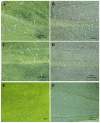



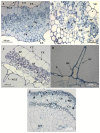

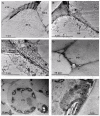

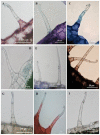
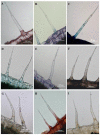
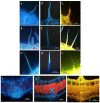
Similar articles
-
Micromorphology, histochemistry and ultrastructure of the foliar trichomes of Withania somnifera (L.) Dunal (Solanaceae).Planta. 2015 Nov;242(5):1107-22. doi: 10.1007/s00425-015-2341-1. Epub 2015 Jun 11. Planta. 2015. PMID: 26063189
-
Glandular trichomes of Robinia viscosa Vent. var. hartwigii (Koehne) Ashe (Faboideae, Fabaceae)-morphology, histochemistry and ultrastructure.Planta. 2020 Nov 12;252(6):102. doi: 10.1007/s00425-020-03513-z. Planta. 2020. PMID: 33180181 Free PMC article.
-
Glandular trichomes of Ceratotheca triloba (Pedaliaceae): morphology, histochemistry and ultrastructure.Planta. 2012 Oct;236(4):1215-26. doi: 10.1007/s00425-012-1671-5. Epub 2012 Jun 14. Planta. 2012. PMID: 22696008
-
Foliar microstructure and histochemical analysis of the lavender tree (Heteropyxis natalensis Harv.).Micron. 2022 Feb;153:103184. doi: 10.1016/j.micron.2021.103184. Epub 2021 Nov 18. Micron. 2022. PMID: 34837864
-
Flavonoids accumulate in leaves and glandular trichomes of Phillyrea latifolia exposed to excess solar radiation.New Phytol. 2000 Oct;148(1):69-77. doi: 10.1046/j.1469-8137.2000.00743.x. New Phytol. 2000. PMID: 33863030 Review.
References
-
- Hossain F., Saha S., Islam M.M., Nasrin S., Adhikari S. Analgesic and anti-inflammatory activity of Commelina benghalensis Linn. Turk. J. Pharm. Sci. 2014;11:25–32.
-
- Mbazima V.G., Mokgotho M.P., February F., Rees D.J.G., Mampuru L.J. Alteration of Bax-to-Bcl-2 ratio modulates the anticancer activity of methanolic extract of Commelina benghalensis (Commelinaceae) in Jurkat T cells. Afr. J. Biotechnol. 2008;7:3569–3576.
-
- Foden W., Potter L. Commelina benghalensis L. South African National Biodiversity Institute (SANBI) National Assessment: Red List of South African Plants Version 2017.1. [(accessed on 1 March 2021)];2005 Available online: http://redlist.sanbi.org/species.php?species=3576-13.
-
- Webster T.M., Burton M.G., Culpepper A.S., York A.C., Prostko E.P. Tropical spiderwort (Commelina benghalensis): A tropical invader threatens agroecosystems of the southern United States. Weed Technol. 2005;19:501–508. doi: 10.1614/WT-04-234R.1. - DOI
-
- Ghosh P., Dutta A., Biswas M., Biswas S., Hazra L., Nag S.K., Sil S., Chatterjee S. Phytomorphological, chemical and pharmacological discussions about Commelina benghalensis Linn. (Commelinaceae): A review. Pharma Innov. 2019;8:12–18.
Grants and funding
LinkOut - more resources
Full Text Sources
Other Literature Sources

